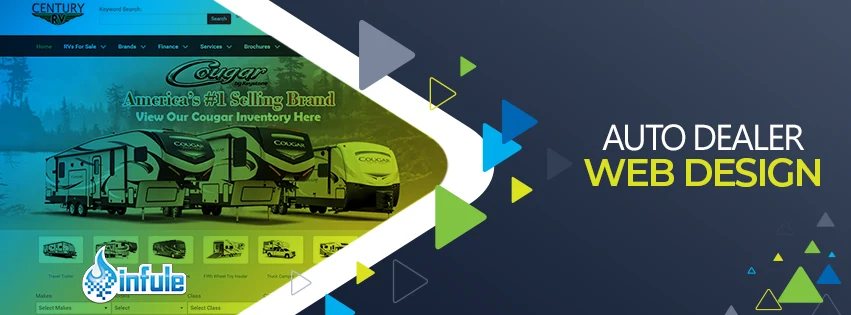Mastering RV SEO Content Strategy: A Step-by-Step Guide for RV Dealers
As an RV dealer, you understand the importance of having a strong online presence to attract potential customers.
To achieve higher website rankings in search engines, a well-structured SEO content strategy is essential. In this comprehensive guide, we’ll walk you through a step-by-step approach to improve your RV dealership’s SEO strategy and generate organic traffic that leads to increased sales and brand visibility.
Step 1: Keyword Research for RV Dealers
Keyword research is the foundation of your SEO content strategy. Start by creating an outline of your customer buying cycle, understanding the stages they go through before making a purchase.
Include all relevant services, topics, and common questions associated with each stage. This will give you valuable insights into the keywords and phrases potential customers use during their buying journey.
Tools like Google Keyword Planner, SEMrush, ahrefs and Ubersuggest can help you identify high-performing keywords related to the RV industry. Look for relevant long-tail keywords that have a good search volume and low competition, as they present excellent opportunities to target specific niches.
Step 2: Creating a Keyword List to Target
To efficiently manage and organize your keyword list, follow these steps: (note, that an online tool will export data in a spreadsheet form, however, you still need to prioritize it.)
- Use a Spreadsheet: Create a new spreadsheet (you can use Google Sheets or Microsoft Excel) to keep track of your keywords. Spreadsheets allow for easy data manipulation and analysis, making it an excellent tool for keyword management.
- Keyword Column: In your spreadsheet, create a column to list all the keywords you’ve discovered during your research. Include both short-tail and long-tail keywords related to RV sales, parts, service, travel, how-to, and any other relevant categories.
- Search Volume Data: Add another column to record the search volume data for each keyword. This data will help you understand the popularity and demand for specific keywords. You can use tools like Google Keyword Planner or SEMrush to find the average monthly search volume.
- Keyword Difficulty: Include a column to assess keyword difficulty. This metric helps you understand how challenging it might be to rank for a particular keyword. Tools like Moz or Ahrefs offer keyword difficulty scores.
- Competitor Analysis: Add a column to track your competitors’ ranking positions for each keyword. This information will provide insights into your competitors’ SEO strategy and where you stand compared to them.
- Target Priority: Create a column for “Rank” (1-5: 5 being the highest priority). Assign a priority rank to each keyword based on its relevance to your dealership and potential to drive conversions.
- Keyword Type or Category: As you mentioned, include a column called “Type” or “Cat” to categorize each keyword based on their topic or theme. This categorization will help you group keywords together for specific content campaigns or target different segments of your audience.
- Content Ideas: Finally, add a column to jot down content ideas or titles associated with each keyword. This will help you plan your blog posts or website pages more effectively.
By using a spreadsheet and organizing your keyword list in this manner, you’ll have a clear overview of your SEO strategy and be able to prioritize your efforts more efficiently. Continuously update and refine this spreadsheet as you progress in your SEO content strategy to stay ahead of your competition and achieve long-term success.
Step 3: Develop a Content Calendar
Having a well-organized content calendar is crucial for consistent content creation. Decide on the frequency of posting new content on your website; ideally, aim for weekly updates, but bi-weekly is acceptable if it suits your resources and timing better.
Use your list of targeted keywords to plan content topics for each blog post. Ensure that each article is unique, informative, and relevant to your audience’s interests and needs.
By addressing common pain points, providing valuable tips, and showcasing industry expertise, you establish your dealership as a go-to resource for your customers.
Step 4: Optimize Technical SEO
While writing your articles, keep in mind technical SEO best practices. Optimize your content by internally linking to other relevant pages on your website using appropriate anchor text.
For example, if you’re writing about “Travel Trailer Remodeling Tips,” link the text to your “Travel Trailers for Sale” section. This internal linking structure strengthens the authority of your website and improves overall SEO.
Step 5: Engage with Local SEO
Local SEO is critical for RV dealers, as many potential customers are searching for local dealerships.
Optimize your website with local keywords such as city names, landmarks, and phrases like “near me” to capture local search traffic.
Ensure your Google My Business listing is up-to-date with accurate contact information, business hours, and customer reviews.
Step 6: Content Promotion and Backlink Building
Promote your RV dealership’s content through various channels, such as social media, email newsletters, and industry forums. Engaging with potential customers on platforms they frequent will boost your content’s visibility and drive organic traffic.
Backlink building is another essential element of SEO strategy. Seek opportunities to collaborate with industry influencers, partners, or local businesses to earn high-quality backlinks to your website. This not only improves your website’s authority in the eyes of search engines but also exposes your brand to new audiences.
Step 7: Monitor, Analyze, and Adjust
Regularly monitor the performance of your content using tools like Google Analytics. Analyze key metrics like organic traffic, time on page, and bounce rate to identify areas for improvement. Based on your findings, adjust your content strategy as needed to cater to your audience’s preferences and optimize for better results.
Conclusion
By following this step-by-step guide to RV SEO content strategy, you’ll establish your dealership as an authoritative industry resource, attract more organic traffic, and improve your website’s search engine rankings.
Consistency, quality content, and a customer-centric approach are key to staying ahead in the competitive RV dealership market. So, start creating compelling content that meets your customers’ needs and watch your online presence soar!
Need help?
We’re here to help with content. Contact us here to help you build a content strategy or if you need help with SEO.


